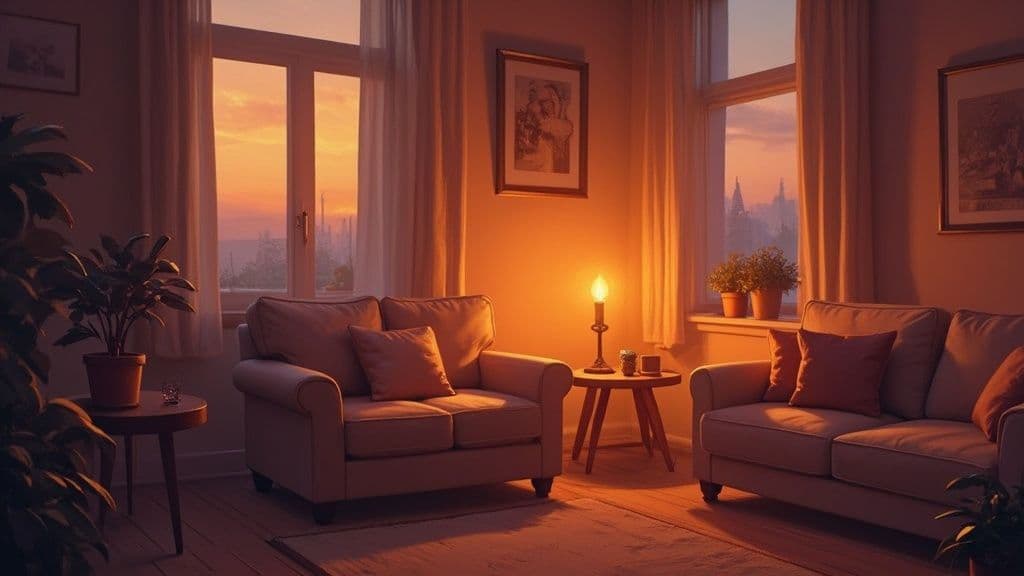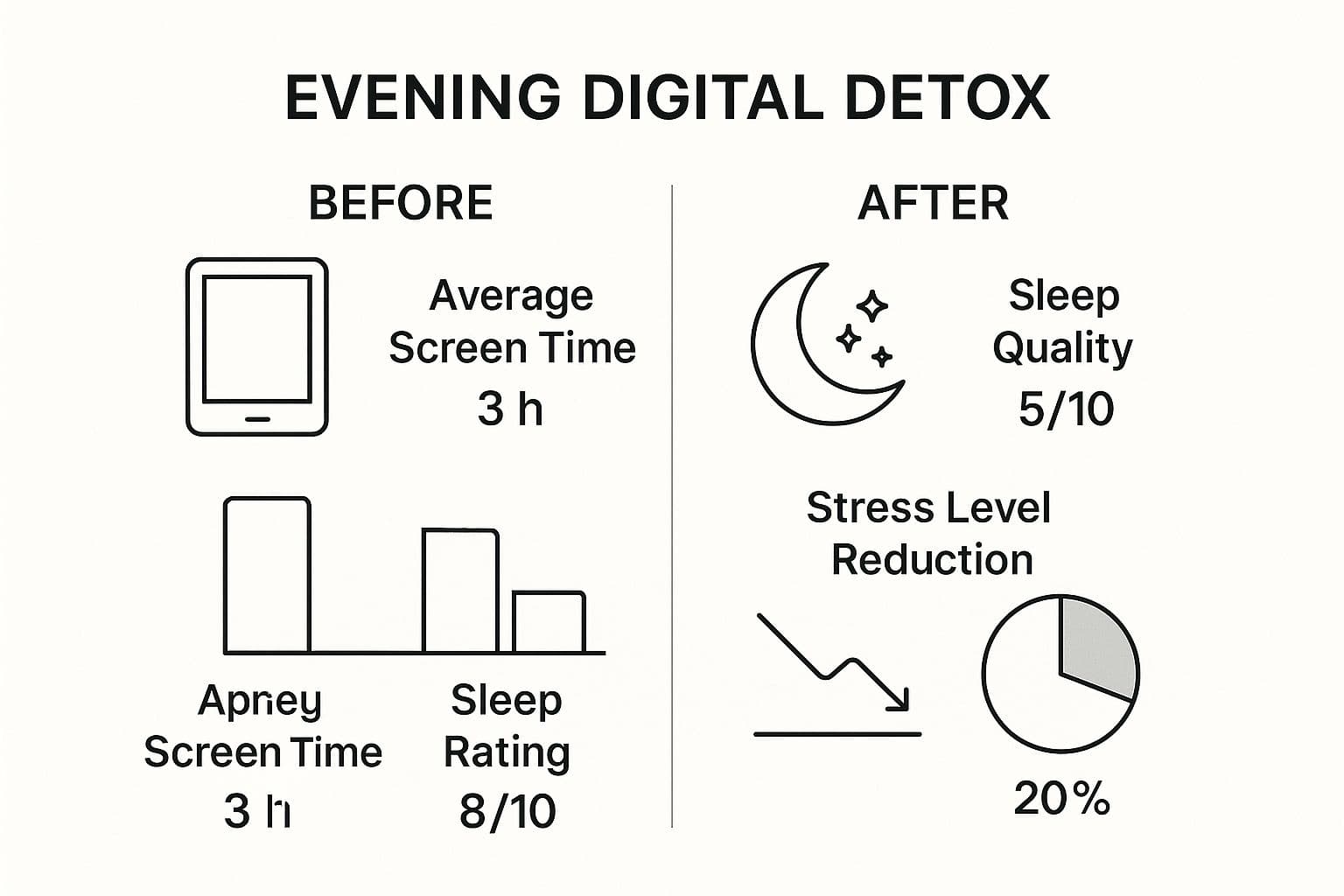Craft a Relaxing Evening Routine for Better Sleep
Discover how a relaxing evening routine can quiet your mind and improve sleep. Get practical tips to unwind, reduce stress, and beat sleep anxiety tonight.
An evening routine is so much more than just flicking off the lights. It’s a deliberate practice, a way to consciously push back against the day's stress and get your mind ready for some real rest. Think of it as creating a buffer zone between your hectic day and your pillow, using specific, calming activities to signal to your body that it's time to power down.
Why a Calmer Evening Is Non-Negotiable

In a world that pings, buzzes, and flashes 24/7, our natural sleep rhythms are under constant attack. The pressure to perform at work, keep things running at home, and stay connected online leaves almost no space for quiet. This relentless pace keeps our nervous systems stuck on high alert, making it nearly impossible to switch off when it's finally time to sleep.
This modern reality has led to a troubling little trend called sleep anxiety. This isn't just a passing worry; it's a persistent, nagging concern about whether you’re getting enough good sleep. A surprising number of people, especially younger adults, find themselves lying awake, stressed about their inability to fall asleep. In fact, nearly 40% of Gen Z adults say they deal with this anxiety multiple times a week, a problem often fueled by being constantly plugged in and living with a backdrop of uncertainty. The Global Wellness Institute has some fascinating insights on how these trends are impacting our rest.
The Pressure for Perfect Sleep
Ironically, our society's obsession with "optimizing" sleep can make everything worse. When you start treating sleep like another task on your to-do list—tracking every minute and analyzing every cycle—it can quickly become a source of performance anxiety. Your bed stops being a sanctuary and turns into a stage where you feel like you have to succeed at resting.
A truly relaxing evening routine isn't about following rigid rules or chasing a perfect eight hours. It’s about giving yourself permission to disconnect and providing your mind with a gentle, predictable path toward tranquility.
Reclaiming Your Final Hours
This is where a deliberate, calming pre-sleep ritual becomes a game-changer. It’s not a luxury; it’s a necessary tool for mental clarity and physical restoration. By consciously taking back the last few hours of your day, you create a protective space, free from the day's demands.
It quiets your mind: Purposeful activities like listening to a story or doing some light stretching shift your focus away from the day's stressors.
It reduces physical stress: Simple actions like dimming the lights and turning down the thermostat send physiological cues to your body that it’s time to rest.
It sets the stage: A consistent routine builds a powerful psychological link between certain activities and sleep, making it easier to drift off naturally over time.
Creating Your Wind-Down Blueprint

Think of a good evening routine less like a rigid, step-by-step manual and more like a personal blueprint. The goal isn’t to follow a strict script every single night. Instead, it’s about sending consistent, gentle signals to your body and mind that the day is coming to a close. You're creating a transition—a bridge from the chaos of your day to the quiet of your night.
This all starts with consistency. The first thing you need is an anchor, a specific "wind-down time" that you stick to. Let's say 9:00 PM. This isn't your bedtime, but the moment you consciously decide to shift gears. Setting a recurring alarm on your phone labeled “Downtime Begins” can be a surprisingly powerful cue to start your pre-sleep ritual.
The Digital Sunset
One of the most crucial parts of this blueprint is what I call the digital sunset: powering down all your screens at least 60-90 minutes before you actually plan to fall asleep. It's no secret that the blue light from our phones, tablets, and TVs is a notorious enemy of sleep, suppressing the melatonin your body needs to feel tired.
I know, I know—disconnecting is hard. But it’s one of the most impactful things you can do for your sleep. You can even use technology against itself. A few smart plugs can automatically turn off your Wi-Fi router or television at a set time. Or, try activating your phone’s “downtime” or “grayscale” mode. Endless scrolling is a lot less tempting when everything is in drab shades of grey.
Your pre-sleep environment is just as important as the activities you perform. Small adjustments to your surroundings can have a significant physiological impact, preparing your body for deep rest long before your head hits the pillow.
Tune Your Environment for Sleep
Finally, let’s talk about your physical space. You don't need a massive overhaul. Just a few simple tweaks to your surroundings can signal tranquility to your brain.
Dim the Lights: An hour or two before bed, start lowering the lights. This mimics a natural sunset and cues your body for rest. Swap out those bright, harsh overhead lights for warm, low-wattage lamps. The difference in atmosphere is immediate.
Adjust the Temperature: Your body temperature naturally drops as it prepares for sleep. You can help this process along by setting your thermostat to a cooler temperature. The sweet spot for most people is between 60 and 67 degrees Fahrenheit (15-19°C).
These small environmental cues work in harmony, reinforcing the message that it’s time to unwind. When you intentionally craft this blueprint, you're not just hoping for a good night's sleep—you're building a reliable pathway to get there.
Mindful Activities to Calm Your Nervous System
Now that you’ve set the scene, it’s time to bring in some specific, mindful activities that will actively calm your nervous system. An effective evening routine isn't about following a rigid, one-size-fits-all schedule. It's about building your own personal menu of calming options to choose from each night, depending on what feels right for you.
A warm bath or shower is a classic for a good reason. Sure, the warm water is great for relaxing tense muscles, but the real magic happens after you get out. As your body cools down, its temperature naturally drops—a powerful physiological signal to your brain that it's time to sleep.
Gentle Movement and Mindful Reflection
If a bath isn't your style, consider some gentle movement. You don't need a full-blown yoga class. Just five to ten minutes of slow, deliberate stretching, like a simple cat-cow pose or a gentle hamstring stretch, can do wonders to release the physical tension you've built up all day.
Journaling is another fantastic tool for offloading the day’s mental baggage. This isn't about crafting the perfect diary entry. Think of it more as a "brain dump"—a place to scribble down everything on your mind without any judgment. Getting those thoughts out of your head and onto paper creates a sense of closure, keeping you from ruminating on them once your head hits the pillow.
Many people find that pairing journaling with listening to a story is a powerful way to shift from active thinking to passive relaxation. You can explore some great stories for sleep to see how this combination might fit into your own routine.
By intentionally choosing an activity that soothes both body and mind, you are actively downshifting your nervous system from its "go" mode to its "rest" mode.
Everyone's wind-down ritual is a little different, and the data backs this up. For instance, 32% of people prefer taking a shower to relax, while 20.4% curl up with a book. Another 23.9% make a point to talk with their partner, showing that connection can be just as calming as solitude. You can dive deeper into these varied sleep preparation habits in the full breakdown over at NapLab.com.
Choosing Your Ideal Wind-Down Activity
Finding the right activity can feel like a bit of trial and error. To help you get started, here's a quick comparison of a few popular options.
Activity | Primary Benefit | Average Time Commitment |
Warm Bath/Shower | Muscle relaxation & body temperature regulation | 15–20 minutes |
Gentle Stretching | Physical tension release | 5–10 minutes |
Journaling | Mental offloading & thought processing | 5–15 minutes |
Reading a Book | Cognitive distraction & imagination engagement | 15–30 minutes |
Listening to a Story | Passive relaxation & reduced screen time | 10–30+ minutes |
Ultimately, the best choice is the one you can stick with consistently. Mix and match until you find what truly helps you unplug from the day.
This image really highlights the dramatic impact that even small adjustments, like cutting down on screen time, can have on how well you sleep and how stressed you feel.

As you can see, simply putting your phone away earlier can significantly boost your perceived sleep quality and lower stress. It’s a simple change, but it’s a cornerstone of any effective evening routine.
Using Audio to Deepen Your State of Calm

Once your physical space feels calm, it's time to bring in sound. The right audio can be an incredibly powerful tool, guiding your mind away from the persistent chatter of the day and into a state of genuine quiet. This isn't just about putting on a mellow playlist; it’s about intentionally using sound to build your evening sanctuary.
A surprisingly effective option is bedtime stories for adults. They work because they give your busy mind a gentle narrative to follow, making it almost impossible to get stuck in those frustrating loops of worry or tomorrow’s to-do list. The structure of a story—with its beginning, middle, and end—is inherently comforting. It often brings back a sense of nostalgia and safety from childhood, making it a simple, screen-free way to fully disengage.
Layering Sound for a Deeper Calm
Beyond stories, you can explore other forms of immersive audio. Think of it like building a custom soundscape. Each type of sound offers a different path to tranquility, so you can find what your mind needs on any given night.
Guided Sleep Meditations: These audio tracks are perfect when you’re feeling physically tense. They walk you through breathing exercises or body scans, helping you release tension you might not even realize you’re holding onto in your shoulders or jaw.
Immersive Soundscapes: Sounds like a crackling fireplace or a steady, gentle rain are fantastic for masking disruptive noises from inside or outside your home. The consistent, non-jarring nature of these sounds is incredibly soothing for an overstimulated nervous system.
Binaural Beats: This technique is a bit more scientific. It involves playing slightly different frequencies in each ear, which your brain interprets as a single, rhythmic pulse. Many people find this helps them sink into a meditative state much more quickly.
The goal here isn't just to distract yourself. It's to actively create a sensory environment where relaxation feels effortless. You’re giving your mind a peaceful focal point, allowing your body to follow its lead.
Many dedicated apps and players, like the one we built here at Otherworld Tales, let you mix these elements together. For instance, you can layer the narration of a story over the gentle rumble of distant wind.
If you're curious about how specific sounds can impact rest, you can learn more about using wind noise for sleep in our detailed guide. Experimenting with these combinations is the best way to build a routine that feels truly personal and, most importantly, effective for you.
Making Your Routine Stick for the Long Haul
Let's be honest. The most effective evening routine isn't some picture-perfect one you saw on social media—it's the one you actually do. Forget the pressure to get it right on the first try. The real goal here is consistency, finding a ritual that feels like a reward, not just another chore on your to-do list.
This means you have to give yourself permission to experiment. Maybe journaling feels like homework, but a few minutes of gentle stretching feels incredible. Perhaps a warm bath is too much hassle on a weeknight, but listening to a story while sipping herbal tea is the perfect sweet spot. Play around with different activities and, most importantly, notice how they make you feel. The whole point is to build a flexible routine you genuinely look forward to.
Find Your Own Rhythm
There's no universal blueprint for winding down, and you can see this reflected in habits all over the globe. For example, some fascinating sleep data shows just how much our rest patterns vary. Women in South Africa average around 9.3 hours of sleep, while those in the United States clock in at 8.9 hours.
These differences drive home the point that how we unwind is deeply personal. But the one powerful, shared secret for better rest? Having a consistent routine, a practice embraced by 59% of people globally. You can dive into more of these findings about global sleep statistics on Media.Market.us.
The secret to a lasting routine is making it your own. It needs to adapt to your life, not the other way around. If you have a late night, just shorten your ritual instead of skipping it entirely.
Embrace that flexibility. A sustainable routine isn't about rigid rules. It's about creating a reliable pathway to calm that you can turn to night after night, no matter what the day throws at you.
What to Do When Your Evening Routine Gets Derailed
Even the most perfectly planned evening routine will eventually run into a wall. That's just life. An unexpected late night at work, a last-minute trip, or just one of those evenings where sleep feels impossible. The secret isn't to have a bulletproof plan, but to know how to adapt when things go sideways.
So, what do you do when your evening is shot and you get home hours late? Your first instinct might be to just crash, skipping the routine altogether. Resist that urge. This is the perfect time for a "micro-routine."
Instead of the full wind-down, just pick one or two essential elements. Maybe it's just 5 minutes of deep breathing. Or perhaps you listen to the first few minutes of a favorite audio story. A small piece of your ritual is infinitely better than nothing—it keeps the habit alive and still signals to your brain that it's time for rest.
Staying Grounded While Traveling
Travel is another classic routine-killer. A sterile hotel room is a far cry from your familiar sanctuary, but you can bring a small piece of that comfort with you.
Pack your favorite herbal tea. Download a few go-to audio stories onto your phone so you don't have to rely on spotty hotel Wi-Fi. The goal is to recreate the sensory cues—the scent of your tea, the familiar sound of a narrator's voice—that your brain associates with relaxation. This can make an unfamiliar space feel much more like home.
Your evening routine is a tool, not a test. The goal is to feel better, not to achieve perfection. If something isn't working, adjust it without judgment.
But what if you do everything "right" and still find yourself staring at the ceiling, wide awake? First, don't panic. Lying in bed getting frustrated is the most counterproductive thing you can do.
Instead, get up. Just for a few minutes. Move to another dimly lit room and do something quietly engaging that doesn't involve a screen. Read a chapter of a physical book or listen to a calming audio story. Our ultimate guide to bedtime stories for adults has some great suggestions for non-stimulating narratives.
The idea is to break the cycle of anxiety you're building around your bed. Once you feel your eyelids getting heavy again, head back to your room. This simple act reinforces a powerful message: your bed is for sleeping, not for worrying.
Ready to make immersive audio a core part of your evening? Otherworld Tales offers a library of original fantasy and mythology stories designed to quiet your mind. Mix narration with ambient sounds like rain or a crackling fire to create your perfect escape. Start listening for free tonight.